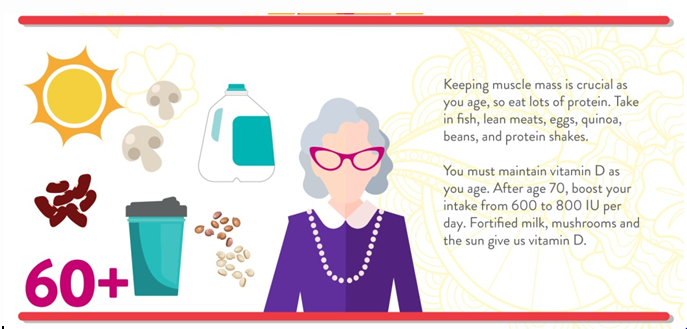Elevate your health with optimal calcium levels
Elevate your well-being with optimal calcium levels. Discover the key to stronger bones and overall vitality. Unlock a healthier you today.
Women in general, are busy catering other’s needs in the house. Rarely will they stop and take a look at themselves, let alone, focus on their changing nutritional needs as they age.

(Photo: Getty Images)
Women in general, are busy catering to the needs of other members in the family. Very rarely they get a chance to take care of themselves. let alone, stress on their changing nutritional needs as they age. Prioritizing one’s own nutrition is vital, especially after the age of 40, it becomes imperative to keep you healthy and spirited. If you want to remain fit, here is your decade-by-decade guide:
During your 40s and 50s…

Advertisement
Befriend B12: Vitamin B12, which supports the health of both your red blood cells and nervous system, is vital to keep you energized. However, throughout the years, your body’s ability to absorb and use the B12 you eat may wane. That is because your gut gradually produces less Intrinsic factor, a protein necessary for the intestines to effectively absorb B12. “B12 deficiency is very common amongst the Indian population due to poor dietary intake,” says Dr. Ganesh Kadhe, Associate Director Medical & Scientific Affairs at Abbott Nutrition.
Consume more calcium: While calcium can help strengthen your bones in every stage of life, after the age of 50, your daily recommended intake increases from 1,000 to 1,200 mg per day. It is important to talk to your doctor to evaluate your bone density, family history and calcium intake to prevent osteoporosis or to help slow the loss of bone density as you age.
To increase your calcium intake, focus on incorporating whole foods including dairy, sardines, soy, leafy vegetables and salmon into your diet.
Eat more fiber: In women, the risk of coronary heart disease increases after the age of 55, according to the National Heart, Lung, and Blood Institute. That’s where fiber comes in, helping to lower cholesterol levels and improve heart health.
To increase your levels of soluble, cholesterol-lowering fiber, reach for oat bran, barley, nuts, seeds, beans, lentils, peas, fruits, and vegetables. Increase intake gradually to prevent stomach upset.
During your 60s and beyond…

Preserve muscle with protein: To walk your children down the aisle or run around the backyard with your grandchildren, it’s important to maintain muscle mass. We naturally start losing muscle mass at 40 years old – roughly 8 percent per decade and this number can nearly double to 15 percent at the age of 70.
But to prevent the muscle weakness, you should pair regular physical activity and strength-building exercise with additional protein. According to research published in the Journal of the American College of Nutrition, as you age, the body becomes less efficient at processing protein and incorporating it into your muscles. Incorporate protein-rich foods into every meal and snack. Fish, lean meats, eggs, beans, and protein shakes are all great options.
Get more of the sunshine vitamin: While you can get vitamin D in limited quantity from foods such as fortified milk, salmon, and mushrooms, the vast majority of its intake comes through the sun exposure. Unfortunately, many people don’t get enough of the important vitamin—and deficiency is increasingly common in old age. In one of the studies, of 824 elderly people, published in The American Journal of Clinical Nutrition, 47 percent of women were deficient in vitamin D throughout the winter, when vitamin D levels are generally at their lowest. Dr. Ganesh Kadhe points out that during old age, apart from spending less time outside, people can experience reduced skin thickness, impaired intestinal absorption, poor food intake of vitamin D and reduced liver and kidney function, further increasing the risk of deficiency.
For that reason, after you cross the age of 70, the recommended daily intake of vitamin D increases from 600 to 800 IU ( International Unit) per day. To attain this, talk to your primary care physician.
(Dr. Ganesh Kadhe, Associate Director Medical & Scientific Affairs at Abbott Nutrition )
Advertisement